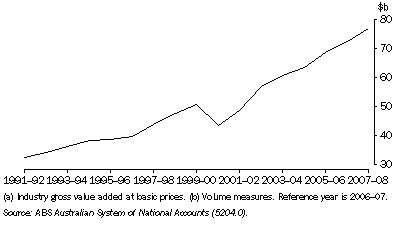CONSTRUCTION INDUSTRY
The contribution of an industry to the overall production of goods and services in an economy, gross domestic product (GDP), is measured by gross value added (GVA). Information on the relationship between industry GVA and GDP is provided in the Industry structure and performance chapter.
Total production of the construction industry, as measured by GVA (in volume terms), generally increased from 1991-92 to 1999-2000. The peak in 1999-2000 was followed by a sharp decline. Construction industry GVA (in volume terms) has increased steadily since 2000-01, and in 2007-08 reached $77 billion (b) (graph 21.1).
In 2007-08 the construction industry's share of the total production of goods and services in the Australian economy (GDP) was 7%.
21.1 Construction Production(a)(b)

In 2008-09 the construction industry employed an average of 988,000 people (table 21.2), 2% higher than in 2007-08. The number of employees and own account workers increased by 3% and less than 1% respectively since 2007-08, while the number of employers fell by 2%. Own account workers are people who operate their own unincorporated economic enterprise or engage independently in a profession or trade, and hire no employees.
In 2008-09 the majority of construction industry employment was in construction services (654,600 people or 66%), which includes those engaged in services such as earthmoving, concreting, bricklaying, roofing, plumbing, electrical, carpentry, painting, glazing and landscaping. Building construction includes the construction of houses, other residential buildings and non-residential buildings. In 2008-09 average annual employment in building construction decreased by 3% to 238,300 people.
21.2 CONSTRUCTION INDUSTRY, Employment(a) |
|
 |  | 2007 - 08 | 2008 - 09 |
 |  | '000 | '000 |
|
| Building construction |  |  |
 | Employee | 204.0 | 198.6 |
 | Employer | 9.3 | 8.4 |
 | Own account worker(b) | 31.5 | 30.4 |
 | Total(c) | 245.7 | 238.3 |
| Heavy and Civil Engineering Construction |  |  |
 | Employee | 56.0 | 64.2 |
 | Employer | 1.0 | 1.9 |
 | Own account worker(b) | 3.4 | 3.1 |
 | Total(c) | 60.4 | 69.2 |
| Construction Services |  |  |
 | Employee | 408.6 | 419.2 |
 | Employer | 43.7 | 42.5 |
 | Own account worker(b) | 185.6 | 189.3 |
 | Total(c) | 640.4 | 654.6 |
| Total construction(d) |  |  |
 | Employee | 685.2 | 706.4 |
 | Employer | 54.3 | 53.2 |
 | Own account worker(b) | 221.9 | 223.8 |
 | Total(c) | 964.8 | 988.0 |
|
| (a) Annual average of quarterly data. |
| (b) A worker that hires no employees. |
| (c) Includes contributing family worker. |
| (d) Includes categories Building Construction, Heavy and Civil Engineering, Construction, Construction Services and Construction nfd. |
| Source: ABS Labour Force, Australia, Detailed, Quarterly (6291.0.55.003). |
The Australian Bureau of Statistics compiles two price indexes relating to the construction industry - the Price Index of Output of the General Construction Industry, and the Price Index of Materials Used in Home Building. Information on recent trends in these indexes is provided in Construction industries indexes in the
Prices chapter.
 Print Page
Print Page